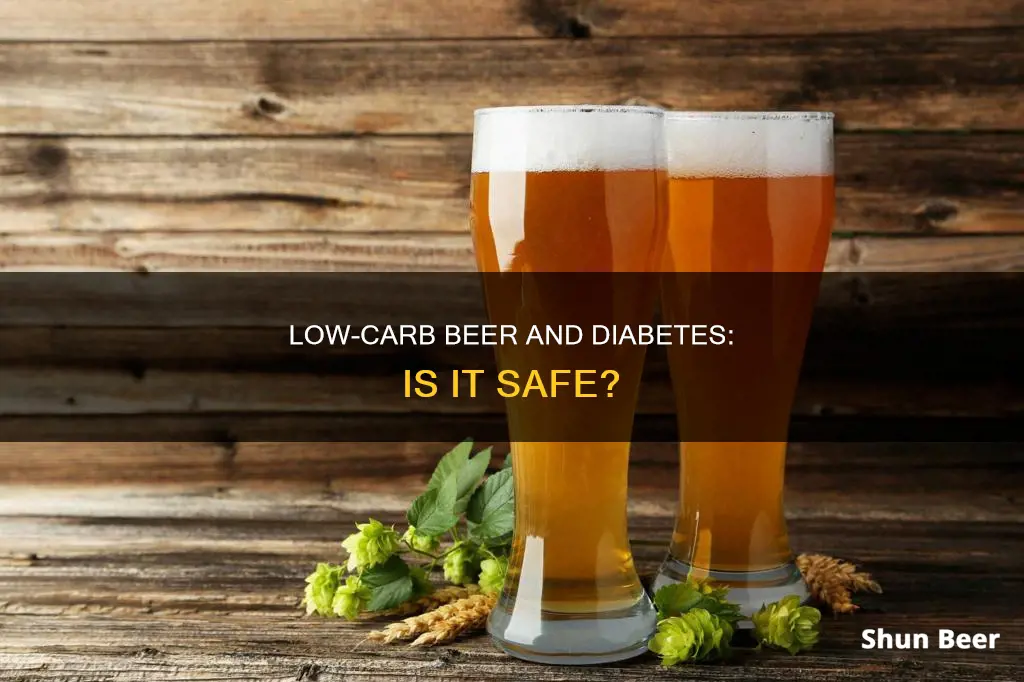
People with diabetes do not need to cut alcohol out of their diet. However, there are some important safety considerations. Alcohol competes with the liver's ability to produce glucose when blood sugar is low, and can lead to hypoglycaemia. Therefore, it is important to drink moderately, and to have food with your drink. Beer is typically higher in carbs than other alcoholic drinks, but there are some lower-carb options available. These include Miller Lite, Coors Light, and Bud Light.
| Characteristics | Values |
|---|---|
| Can diabetics drink beer? | Yes, but in moderation. |
| Recommended daily alcohol intake for diabetics | No more than one drink per day for women, and up to two drinks per day for men. |
| One drink is defined as | 12 fluid oz (fl oz), which equals 360 milliliters (mL) of regular beer (5% alcohol) |
| Low-carb beers | Miller Lite, Coors Light, Bud Light, Busch beers, Corona Premier, Michelob Ultra, Lagunitas Daytime IPA |
| Beer calories | A can of beer has approximately 150 calories |
| Beer carbohydrates | A can of beer has about 15 grams of carbohydrates |
| Beer and blood sugar | Beer raises blood sugar levels as it contains sugar in the form of maltose or maltodextrin. |
| Preventing hypoglycaemia | Don't drink on an empty stomach. Eat a balanced meal with protein, fibre and healthy fats. |
| Checking blood sugar | Check blood sugar before, during, and up to 24 hours after drinking. |
What You'll Learn

Diabetics can drink low-carb beer in moderation
Beer is typically higher in carbs than other alcoholic drinks like wine or liquor. However, the carb content of beers can vary widely depending on the type of beer. "Light" beers have the fewest carbs, usually 5 or fewer grams per serving, and are also lower in alcohol content. For example, Miller Lite and Coors Light are American-style light lagers that provide 3.2 grams and 5 grams of carbohydrates per 12-ounce serving, respectively. On the other hand, hoppy craft beers like IPAs and stouts tend to be much higher in carbs, typically containing 15 grams or more per serving. They also tend to be higher in calories and alcohol content.
When it comes to drinking beer, diabetics should follow the general alcohol consumption recommendations of no more than one drink per day for women and up to two drinks per day for men. It is also important to drink in moderation and not to binge drink. Binge drinking is defined as consuming more than four drinks for women or five drinks for men within a two-hour period. To avoid hypoglycemia, diabetics should also avoid drinking on an empty stomach and should eat a meal with protein, fiber, and healthy fats before drinking. Checking blood sugar levels before, during, and up to 24 hours after drinking is crucial to staying within a safe zone.
In addition to low-carb beers, there are other alcoholic beverage options that are lower in sugar or carb content and may be suitable for diabetics. These include red and white wines, distilled spirits such as gin, rum, vodka, or whiskey, and low-carb cocktails made without sugary juices or syrups. However, it is important to note that alcohol can interfere with diabetes medications, so it is always advisable to consult a healthcare provider before consuming any alcoholic beverages.
Beer and Breast Milk: Does Drinking Beer Help?
You may want to see also

Beer is high in calories
The number of calories in a pint of beer varies depending on the type, with darker and denser beers generally containing more calories and carbs. However, this is not always the case, as some lighter beers can also have a high number of calories due to their sugar content. For example, beers like Peroni, Kronenbourg, Budweiser, Heineken, and Stella Artois have significantly more calories than Guinness due to their higher sugar content.
The impact of beer's calories is further compounded by the fact that alcohol delays the body's fat-burning process. When consumed, the body prioritises processing and eliminating alcohol, causing other functions, including fat burning, to come to a halt. This means that drinking beer can lead to excess calorie consumption and prevent the body from burning fat, increasing the risk of weight gain and belly fat.
Additionally, the hops used to flavour beer are high in phytoestrogens, plant compounds that can mimic the action of the female sex hormone oestrogen. This can potentially lead to hormonal changes in men that increase the risk of storing belly fat.
To manage calorie intake, it is recommended to choose low-calorie and low-carb beers, such as skinny lager, which has significantly fewer calories than regular lager options. It is also important to drink in moderation, following the recommended guidelines of no more than one drink per day for women and up to two drinks per day for men.
Cialis and Beer: A Safe Mix?
You may want to see also

Diabetics should not drink on an empty stomach
To prevent hypoglycaemia, it is recommended that diabetics eat a balanced meal containing protein, fibre, and healthy fats before drinking. This will slow the absorption of alcohol in the body, keeping blood sugar levels more stable. It is also important for diabetics to monitor their blood sugar levels before, during, and up to 24 hours after drinking.
In addition to eating before drinking, there are several other precautions that diabetics should take when consuming alcohol. Firstly, it is important to stick to the recommended alcohol intake guidelines, which suggest no more than one drink per day for women and up to two drinks per day for men. Diabetics should also be mindful of the carbohydrate content of their drinks, as alcohol with a higher carbohydrate content can increase the risk of high blood sugar. It is recommended to choose lower-carbohydrate options when possible. Finally, diabetics should be cautious when mixing alcohol with other medications, as this can further increase the risk of hypoglycaemia.
By following these guidelines and consulting with their healthcare providers, diabetics can make informed choices about alcohol consumption and take the necessary precautions to manage their blood sugar levels effectively.
Deep Cleaning: Beer Drinking Post-Procedure, Is It Safe?
You may want to see also

Alcohol interferes with the liver's ability to produce glucose
Alcohol can interfere with the liver's ability to produce glucose. The liver is responsible for detoxifying the body of alcohol, and when it is busy breaking down alcohol, it may not release enough glucose to keep blood sugar levels high. This can lead to hypoglycaemia, especially if the person is taking insulin or medications that increase insulin production.
The liver is also responsible for stabilising glucose levels by storing carbohydrates and releasing them into the bloodstream between meals and overnight. When a person consumes alcohol, the liver prioritises metabolising it over maintaining blood glucose levels, which can lead to hypoglycaemia. This is more likely to occur when drinking on an empty stomach, as the liver has to work harder to metabolise the alcohol, and there is no food to slow the absorption of alcohol into the bloodstream.
The symptoms of hypoglycaemia and intoxication can be similar, such as slurred speech, drowsiness, confusion, and difficulty walking. This can make it difficult to tell the two conditions apart, especially as alcohol can cloud a person's judgement, and they may not realise that their blood sugar is low. Hypoglycaemia can also occur several hours after drinking, as alcohol can continue to affect the body and the liver for some time after consumption. Therefore, it is important for people with diabetes to monitor their blood sugar levels before, during, and up to 24 hours after drinking alcohol.
To prevent hypoglycaemia when drinking alcohol, it is recommended to consume alcohol with food and to pace drinks, having no more than one drink per hour and no more than three to four drinks total in a day. It is also important to be aware of serving sizes, as some cans and bottles of beer may contain more than the standard 12 ounces (355 ml). Additionally, people with diabetes should consult their healthcare provider about how to adjust their medications, including insulin, on days they consume alcohol.
Non-Alcoholic Beer: A Safe Choice or a Relapse Risk?
You may want to see also

Diabetics should combine drinks with complex carbs
Diabetics should be mindful that drinking alcohol may be risky due to its carbohydrate content, which can cause dangerous fluctuations in their sugar levels. Therefore, it is recommended that diabetics combine their drinks with complex carbohydrates like millet, oats, or tapioca. These foods can help to slow down the absorption of alcohol and stabilise blood sugar levels.
When drinking beer, it is best to opt for low-carb options. A standard beer has, on average, 3.1g of carbohydrates per 100ml, while low-carb beers range between 0.9 and 2.1g per 100ml. Lower-carb beers will also have lower sugar content, which is beneficial for diabetics as sugar can impact blood glucose levels.
It is also important for diabetics to be mindful of the alcohol by volume (ABV) percentage when choosing a beer. Beers with lower ABVs will have closer to 6 grams of carbs, while higher ABV beers may have up to 30 grams of carbs per 12-ounce bottle. Sticking to beers with an ABV of 7% or less can help keep carb intake in check.
Additionally, diabetics should be aware of serving sizes. One drink is considered to be 12 ounces for beer, 5 ounces for wine, and 1.5 ounces for distilled spirits. It is recommended to not exceed one drink per day for women and two drinks per day for men.
To further prevent blood sugar spikes, diabetics should avoid drinking on an empty stomach and instead pair their alcoholic beverage with a balanced meal that includes protein, fibre, and healthy fats. This will slow down the absorption of alcohol and keep blood sugar levels more stable.
It is also crucial for diabetics to monitor their blood sugar levels before, during, and up to 24 hours after drinking. Staying within a safe blood sugar zone, such as 70-180 mg/dL, is important to prevent hypoglycaemia.
Mixing Beer and Xanax: What's the Danger?
You may want to see also
Frequently asked questions
Yes, diabetics can drink beer, but they should be mindful of the amount of alcohol and carbohydrates in their drink. Beer can cause blood sugar spikes and fluctuations, so diabetics should be cautious and check their blood sugar levels before, during, and up to 24 hours after drinking.
There are several low-carb beer options available, such as Miller Lite, Coors Light, and Bud Light. These beers typically have fewer than 5 grams of carbohydrates per 12-ounce serving.
Beer contains sugar in the form of maltose or maltodextrin, which can cause a spike in blood sugar levels. Alcohol also interferes with the liver's ability to produce glucose, which can lead to hypoglycemia or low blood sugar.
Diabetics should drink in moderation, following the recommended guidelines of no more than one drink per day for women and up to two drinks per day for men. It is also important to drink slowly, hydrate with water between drinks, and avoid drinking on an empty stomach. Eating a balanced meal with protein, fiber, and healthy fats can help slow the absorption of alcohol and keep blood sugar levels stable.







